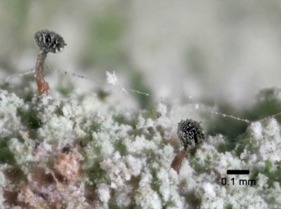Taitaia is a single-species fungal genus in the family Gomphillaceae. It was circumscribed in 2018 to contain the species Taitaia aurea, a lichenicolous (lichen-dwelling) fungus. This species is characterized by aggregated ascomata with yellow margins, and salmon-red discs that originate from a single base. It is known only from a few sites in Kenya's tropical lower-mountain forests, where it grows on thalli of the lichen Crocodia.

Muellerella ventosicola is a species of lichenicolous fungus in the family Verrucariaceae. It shows preference to growing on species of the genus Rhizocarpon but can also associate with other genera.
Xenonectriella nephromatis is a species of lichenicolous fungus in the family Nectriaceae. Found in Alaska, it was described as a species new to science in 2020 by Sergio Pérez-Ortega. The type specimen was discovered in the Hoonah–Angoon Census Area in Glacier Bay National Park, where it was growing on a Nephroma lichen. The specific epithet alludes to this host lichen.
Sclerococcum fissurinae is a species of lichenicolous fungus in the family Dactylosporaceae. Found in Alaska, it was formally described as a new species in 2020 by Sergio Pérez-Ortega. The type specimen was collected in the Hoonah-Angoon Census Area, just outside of Glacier Bay National Park. Here it was found growing on the script lichen species Fissurina insidiosa, which itself was growing on the bark of an alder tree. The specific epithet refers to its host.
Nanostictis caucasica is a species of lichenicolous (lichen-eating) fungus in the family Stictidaceae. It is known to occur only in a single locality in the North Caucasus region of Southern Russia, where it grows parasitically on the foliose lichen Parmelia sulcata.
Opegrapha vulpina is a species of lichenicolous (lichen-eating) fungus in the family Opegraphaceae. It is found in the Czech Republic, Dobruja, Romania, and the Italian Apennine Mountains. It grows parasitically on two species of saxicolous (rock-dwelling), crustose lichens.
Zwackhiomyces polischukii is a species of lichenicolous (lichen-eating) fungus in the family Xanthopyreniaceae. It occurs in Ukraine, where it parasitises the crustose lichens Bacidia fraxinea and B. rubella.
Buelliella lecanorae is a species of lichenicolous (lichen-eating) fungus in the class Dothideomycetes. It is found in a few locations in Estonia and in Crimea, where it grows parasitically on members of the Lecanora subfusca species group.
Clypeococcum bisporum is a species of lichenicolous (lichen-eating) fungus in the family Polycoccaceae. It is found in the Russian Far East, in Mongolia, and from northwest Alaska, where it grows parasitically on lichens from the genera Cetraria and Flavocetraria.
Neoechinodiscus kozhevnikovii is a species of lichenicolous (lichen-eating) fungus in the order Helotiales. It is known to occur in Russia, Austria, and Switzerland, where it grows parasitically on lichens in genus Cetraria.
Graphium samogiticum is a little-known species of lichenicolous (lichen-eating) fungus in the family Microascaceae. It is found in Lithuania, where it parasitises two lichen species that inhabit abandoned gravel pits.
Opegrapha verseghyklarae is a little-known species of lichenicolous (lichen-eating) fungus in the family Opegraphaceae. It is found in the Russian Far East, where it grows on the thalli and apothecia of the crustose lichen Ochrolechia pallescens.
Gallowayella aphrodites is a species of corticolous (bark-dwelling), foliose (leafy) lichen in the family Teloschistaceae. It is found in the Mediterranean countries Greece, Cyprus, and Italy. Characteristics of the lichen include its small thallus, the disposition of the rhizines on the thallus undersurface, and the lack of vegetative propagules.
Halospora is a genus of lichenicolous (lichen-dwelling) fungi in the family Verrucariaceae. Species in the genus parasitise calcicolous crustose lichens, i.e., those that prefer lime-rich substrates.
Plectocarpon galapagoense is a species of lichenicolous fungus in the family Lecanographaceae. Native to the Galápagos Islands, it grows on and within the ascomata and thallus of Sarcographa tricosa, a host lichen species. Although it appears to be a weak parasite, it may cause significant damage to the host lichen's reproductive structures.
Candelariella lichenicola is a rare species of lichenicolous (lichen-dwelling) fungus in the family Candelariaceae. This species was first found in Sonora, Mexico, and is characterised by its distinct spore shape and chemical composition. It is typically found growing on the lichen species Candelina submexicana, and while not widespread, it contributes to the ecological diversity of the regions it inhabits.
Lichenopeltella heppiae is a rare species of lichenicolous (lichen-dwelling) fungus in the family Lichenopeltella. It grows on the thallus and apothecia of Heppia despreauxii.
Protothelenella is a genus of fungi in the family Protothelenellaceae. It contains 11 species, some of which form lichens. Protothelenella species have a crustose thallus with spherical to pear-shaped, dark brown to blackish perithecia. Microscopic characteristics of the genus include bitunicate asci with an amyloid tholus, and ascospores that are colourless and contain multiple internal partitions. Some species grow on acidic substrates including rocks, soil, bryophytes, plant detritus or rotten wood. Other species are lichenicolous (lichen-dwelling), growing on species of Solorina, Peltigera, Pseudocyphellaria, or Cladonia.
Zwackhiomacromyces is a genus of lichenicolous (lichen-dwelling) fungi in the family Xanthopyreniaceae. It has two species. The genus is distinguished by its black, pear-shaped fruiting bodies with large, nipple-shaped ostioles that have a granular surface, and a dark, multi-layered wall made up of hyphal cells forming a pseudoparenchymatous structure. The genus is closely related to the similarly named genus Zwackhiomyces.

Chaenothecopsis kilimanjaroensis is a species of lichenicolous (lichen-dwelling) pin lichen in the family Mycocaliciaceae. Found in the cloud forests of Tanzania, it was described as a new species in 2019. These tiny lichens have a short stalk, which can be either single or formed in aggregates on the same thallus. The stalks are medium brown at the base and become translucent in water. This species has unique spores, which contain a single septum, are arranged in a single row in the ascus, and have a surface ornamented with elongated, blister-like structures.


